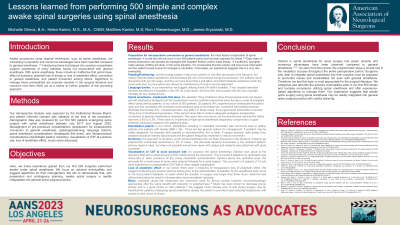Lessons learned from performing 500 simple and complex awake spinal surgeries using spinal anesthesia
Lessons Learned from Performing 500 Simple and Complex Awake Spinal Surgeries Using Spinal Anesthesia
Friday, April 21, 2023


Michelle Olmos, BA (she/her/hers)
Medical Student
Tufts University School of Medicine
Boston, Massachusetts, United States
ePoster Presenter(s)
Introduction: Despite the many benefits of spinal anesthesia described in the literature, numerous barriers to its integration in the practice of neurosurgery remain prevalent. One obstacle is the possibility of eventualities that are not typically encountered with spine surgery under general anesthesia. More specifically, there remains a lack of published guidance on their management.
Methods: We share our experience with 500 simple and complex awake spine surgeries performed under spinal anesthesia and report response algorithms that have been successful in our patient population. Our cohort included 500 patients who received spinal anesthesia for simple and complex spinal surgery between July 2017 and August 2022. Demographic and procedural data was retrospectively collected.
Results: We provide guidance based on our experience with intraoperative conversion to general anesthesia, loss of airway, patient padding and positioning, language barriers, inadequate first spinal dose, and durotomy, among others. In the case of lost airways, preparation for rare intraoperative conversion to general anesthesia entails use of laryngeal mask airways (LMA) if sedation titration and nasal airways fail. Patient padding and positioning are vital in awake, prone surgeries; we have had great success with our unique method of maximizing patient comfort. We also offer recommendations on navigating language barriers in the OR given the importance of patient feedback for determination of anesthetic depth. Inadequate first spinal doses are not unique to spinal surgery and necessitate conversion to general anesthesia. We report a prone dose algorithm shown to decrease anesthetic fail rate, We also outline how to proceed intraoperatively with disinhibited patients, incidental durotomies, CSF visualization at dural puncture sites, loss of anesthetic effect, and how music can reduce pre-operative anxiety.
Conclusion : Given that interest in spinal anesthesia for spine surgery is growing, we hope to inform and educate surgeons wishing to adopt the use of spinal surgery in their practice.
Methods: We share our experience with 500 simple and complex awake spine surgeries performed under spinal anesthesia and report response algorithms that have been successful in our patient population. Our cohort included 500 patients who received spinal anesthesia for simple and complex spinal surgery between July 2017 and August 2022. Demographic and procedural data was retrospectively collected.
Results: We provide guidance based on our experience with intraoperative conversion to general anesthesia, loss of airway, patient padding and positioning, language barriers, inadequate first spinal dose, and durotomy, among others. In the case of lost airways, preparation for rare intraoperative conversion to general anesthesia entails use of laryngeal mask airways (LMA) if sedation titration and nasal airways fail. Patient padding and positioning are vital in awake, prone surgeries; we have had great success with our unique method of maximizing patient comfort. We also offer recommendations on navigating language barriers in the OR given the importance of patient feedback for determination of anesthetic depth. Inadequate first spinal doses are not unique to spinal surgery and necessitate conversion to general anesthesia. We report a prone dose algorithm shown to decrease anesthetic fail rate, We also outline how to proceed intraoperatively with disinhibited patients, incidental durotomies, CSF visualization at dural puncture sites, loss of anesthetic effect, and how music can reduce pre-operative anxiety.
Conclusion : Given that interest in spinal anesthesia for spine surgery is growing, we hope to inform and educate surgeons wishing to adopt the use of spinal surgery in their practice.
